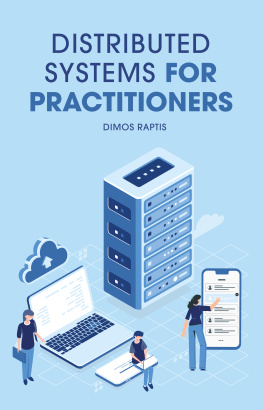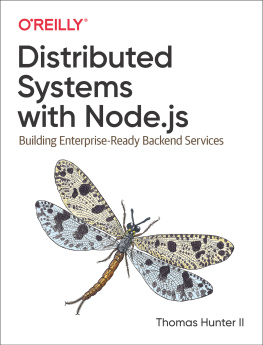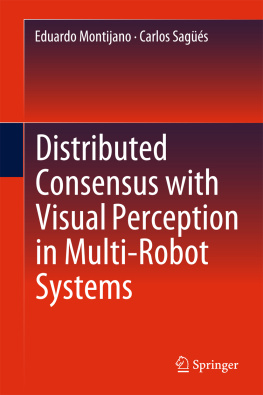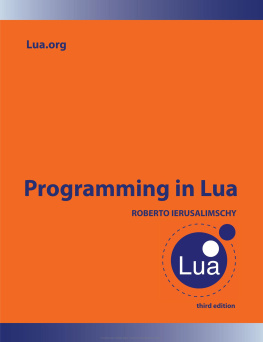Roberto Vitillo - Understanding Distributed Systems
Here you can read online Roberto Vitillo - Understanding Distributed Systems full text of the book (entire story) in english for free. Download pdf and epub, get meaning, cover and reviews about this ebook. year: 2021, genre: Computer. Description of the work, (preface) as well as reviews are available. Best literature library LitArk.com created for fans of good reading and offers a wide selection of genres:
Romance novel
Science fiction
Adventure
Detective
Science
History
Home and family
Prose
Art
Politics
Computer
Non-fiction
Religion
Business
Children
Humor
Choose a favorite category and find really read worthwhile books. Enjoy immersion in the world of imagination, feel the emotions of the characters or learn something new for yourself, make an fascinating discovery.
- Book:Understanding Distributed Systems
- Author:
- Genre:
- Year:2021
- Rating:3 / 5
- Favourites:Add to favourites
- Your mark:
- 60
- 1
- 2
- 3
- 4
- 5
Understanding Distributed Systems: summary, description and annotation
We offer to read an annotation, description, summary or preface (depends on what the author of the book "Understanding Distributed Systems" wrote himself). If you haven't found the necessary information about the book — write in the comments, we will try to find it.
Understanding Distributed Systems — read online for free the complete book (whole text) full work
Below is the text of the book, divided by pages. System saving the place of the last page read, allows you to conveniently read the book "Understanding Distributed Systems" online for free, without having to search again every time where you left off. Put a bookmark, and you can go to the page where you finished reading at any time.
Font size:
Interval:
Bookmark:
Version 1.0.4
Roberto Vitillo
February 2021
Understanding Distributed Systems by Roberto Vitillo
Copyright Roberto Vitillo. All rights reserved.
The books diagrams have been created with Excalidraw.
While the author has used good faith efforts to ensure that the information and instructions in this work are accurate, the author disclaims all responsibility for errors or omissions, including without limitation responsibility for damages resulting from the use of or reliance on this work. The use of the information and instructions contained in this work is at your own risk. If any code samples or other technology this work contains or describes is subject to open source licenses or the intellectual property rights of others, it is your responsibility to ensure that your use thereof complies with such licenses and/or rights.
Authors generally write this page in the third person as if someone else is writing about them. I like to do things a little bit differently.
I have over 10 years of experience in the tech industry as a software engineer, technical lead, and manager.
In 2017, I joined Microsoft to work on an internal SaaS data platform. Since then, I have helped launch two public SaaS products, Product Insights and Playfab. The data pipeline I am responsible for is one of the largest in the world. It processes millions of events per second from billions of devices worldwide.
Before that, I worked at Mozilla, where I set the direction of the data platform from its very early days and built a large part of it, including the team.
After getting my masters degree in computer science, I worked on scientific computing applications at the Berkeley Lab. The software I contributed is used to this day by the ATLAS experiment at the Large Hadron Collider.
Writing a book is an incredibly challenging but rewarding experience. I wanted to share what I have learned about distributed systems for a very long time.
I appreciate the colleagues who inspired and believed in me. Thanks to Chiara Roda, Andrea Dotti, Paolo Calafiura, Vladan Djeric, Mark Reid, Pawel Chodarcewicz, and Nuno Cerqueira.
Doug Warren, Vamis Xhagjika, Gaurav Narula, Alessio Placitelli, Kofi Sarfo, Stefania Vitillo and Alberto Sottile were all kind enough to provide invaluable feedback. Without them, the book wouldnt be what it is today.
Finally, and above all, thanks to my family: Rachell and Leonardo. You always believed in me. That made all the difference.
According to Stack Overflows 2020 developer survey, the best-paid engineering roles require distributed systems expertise. That comes as no surprise as modern applications are distributed systems.
Learning to build distributed systems is hard, especially if they are large scale. Its not that there is a lack of information out there. You can find academic papers, engineering blogs, and even books on the subject. The problem is that the available information is spread out all over the place, and if you were to put it on a spectrum from theory to practice, you would find a lot of material at the two ends, but not much in the middle.
When I first started learning about distributed systems, I spent hours connecting the missing dots between theory and practice. I was looking for an accessible and pragmatic introduction to guide me through the maze of information and setting me on the path to becoming a practitioner. But there was nothing like that available.
That is why I decided to write a book to teach the fundamentals of distributed systems so that you dont have to spend countless hours scratching your head to understand how everything fits together. This is the guide I wished existed when I first started out, and its based on my experience building large distributed systems that scale to millions of requests per second and billions of devices.
I plan to update the book regularly, which is why it has a version number. You can subscribe to receive updates from the books .
If you develop the back-end of web or mobile applications (or would like to!), this book is for you. When building distributed systems, you need to be familiar with the network stack, data consistency models, scalability and reliability patterns, and much more. Although you can build applications without knowing any of that, you will end up spending hours debugging and re-designing their architecture, learning lessons that you could have acquired in a much faster and less painful way. Even if you are an experienced engineer, this book will help you fill gaps in your knowledge that will make you a better practitioner and system architect.
The book also makes for a great study companion for a system design interview if you want to land a job at a company that runs large-scale distributed systems, like Amazon, Google, Facebook, or Microsoft. If you are interviewing for a senior role, you are expected to be able to design complex networked services and dive deep into any vertical. You can be a world champion at balancing trees, but if you fail the design round, you are out. And if you just meet the bar, dont be surprised when your offer is well below what you expected, even if you aced everything else.
roberto@understandingdistributed.systems
A distributed system is one in which the failure of a computer you didnt even know existed can render your own computer unusable.
Leslie Lamport
Loosely speaking, a distributed system is composed of nodes that cooperate to achieve some task by exchanging messages over communication links. A node can generically refer to a physical machine (e.g., a phone) or a software process (e.g., a browser).
Why do we bother building distributed systems in the first place?
Some applications are inherently distributed. For example, the web is a distributed system you are very familiar with. You access it with a browser, which runs on your phone, tablet, desktop, or Xbox. Together with other billions of devices worldwide, it forms a distributed system.
Another reason for building distributed systems is that some applications require high availability and need to be resilient to single-node failures. Dropbox replicates your data across multiple nodes so that the loss of a single node doesnt cause all your data to be lost.
Some applications need to tackle workloads that are just too big to fit on a single node, no matter how powerful. For example, Google receives hundreds of thousands of search requests per second from all over the globe. There is no way a single node could handle that.
And finally, some applications have performance requirements that would be physically impossible to achieve with a single node. Netflix can seamlessly stream movies to your TV with high resolutions because it has a datacenter close to you.
This book will guide you through the fundamental challenges that need to be solved to design, build and operate distributed systems: communication, coordination, scalability, resiliency, and operations.
The first challenge comes from the fact that nodes need to communicate over the network with each other. For example, when your browser wants to load a website, it resolves the servers address from the URL and sends an HTTP request to it. In turn, the server returns a response with the content of the page to the client.
How are request and response messages represented on the wire? What happens when there is a temporary network outage, or some faulty network switch flips a few bits in the messages? How can you guarantee that no intermediary can snoop into the communication?
Font size:
Interval:
Bookmark:
Similar books «Understanding Distributed Systems»
Look at similar books to Understanding Distributed Systems. We have selected literature similar in name and meaning in the hope of providing readers with more options to find new, interesting, not yet read works.
Discussion, reviews of the book Understanding Distributed Systems and just readers' own opinions. Leave your comments, write what you think about the work, its meaning or the main characters. Specify what exactly you liked and what you didn't like, and why you think so.










